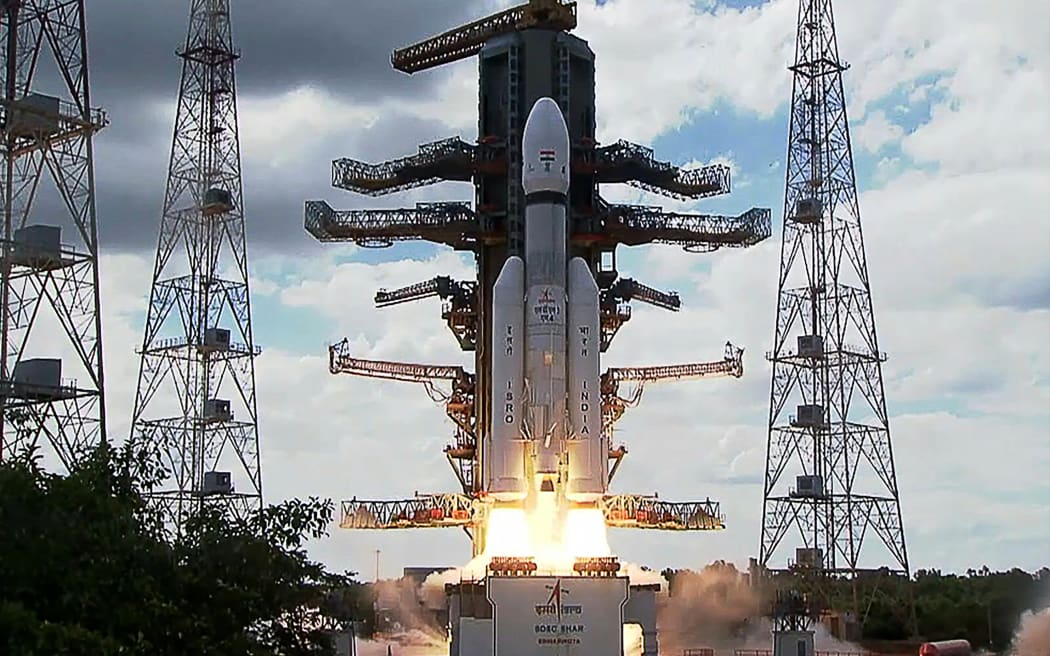New Zealand tech firm has one eye on India’s lunar landing


Photo: AFP
A high-tech New Zealand company is watching with bated breath to see whether India's third lunar mission can successfully land on the moon's south pole overnight as planned.
GPS component manufacturer Rakon has provided several key instruments to assist in the location and timing of navigation systems on the mission's lunar lander and rover vehicles.
Chandrayaan-3 is expected to touch down on the lunar surface at 12.30am on 24 August.
"We are proud to have our products play a role in multiple Indian space research organisation (ISRO) missions," said Sinan Altug, chief executive of Rakon. "These include a custom designed hi-reliability Space OCXO oscillator that provides the main reference clock to the atomic clock onboard the ISRO's GSLV-F12/NVS-01 navigation satellite."
The reliability of the OCXO oscillator installed in Chandrayaan-3 and geosynchronous satellite launch vehicles provides a key advantage of overall frequency stability compared to its temperature range.
The oscillator is widely used in transponders, global navigation satellite system receivers, digital cards, onboard calculators, synthesizers, frequency generation units, navigation instruments, positioning systems, gyroscopes and master clocks.
Rakon has collaborated with Indian space research organisations, as well as related entities such as the U R Rao Satellite Centre and Space Applications Centre, for 15 years.
Over that time, Rakon has developed tech products for Indian space programmes such as GSAT, the Indian regional navigation satellite system, Chandrayaan lunar missions and the Mars orbiter mission, Mangalyaan.
"Currently, we are developing products for upcoming ISRO programmes such as Aditya L1, which is a mission to study the solar atmosphere, and Gaganyaan, which is part of the human spaceflight programme," Altug said. "We work with ISRO to custom design frequency-controlled products specifically to meet their strict mission requirements. The products are developed and manufactured at Rakon's Bengaluru site in India."
In June, Rakon inaugurated its new research and manufacturing centre in Bengaluru, which replaces its former leased sites. The company will also be transferring some product lines that are currently manufactured at sites in New Zealand and France to the new facility.
Graham Rouse, New Zealand's trade commissioner based in Mumbai who attended the opening of Rakon's new facility, noted in a social media post how the company's decade-long manufacturing history is an example of how an innovative New Zealand company can thrive in India, leveraging the local manufacturing eco-system whilst accelerating India's 5G infrastructure and space programme.
While detailing the benefits of advancing its India operations, Rakon believes the added capacity and production diversification will lower risk and provide additional supply chain certainty. It anticipates that annual revenue from its India operations may rise from 25-35 percent of total revenue to around 50 percent.
"As an example of a New Zealand company thriving in India, we support India's ascent as a powerhouse in space exploration and tech manufacturing," Altug said.
"Rakon India is also growing its partnerships to provide high-end oscillators for use in indigenous 5G equipment being developed by the Indian telecom sector, including the state-run company BSNL," he said.
"While continuing to invest in our relationship with ISRO, we are also building our partnerships within India's commercial, low-earth orbit satellite market, through our new suite of products specially designed for this industry."
Photo: AFP
A high-tech New Zealand company is watching with bated breath to see whether India's third lunar mission can successfully land on the moon's south pole overnight as planned.
GPS component manufacturer Rakon has provided several key instruments to assist in the location and timing of...

Photo: AFP
A high-tech New Zealand company is watching with bated breath to see whether India's third lunar mission can successfully land on the moon's south pole overnight as planned.
GPS component manufacturer Rakon has provided several key instruments to assist in the location and timing of navigation systems on the mission's lunar lander and rover vehicles.
Chandrayaan-3 is expected to touch down on the lunar surface at 12.30am on 24 August.
"We are proud to have our products play a role in multiple Indian space research organisation (ISRO) missions," said Sinan Altug, chief executive of Rakon. "These include a custom designed hi-reliability Space OCXO oscillator that provides the main reference clock to the atomic clock onboard the ISRO's GSLV-F12/NVS-01 navigation satellite."
The reliability of the OCXO oscillator installed in Chandrayaan-3 and geosynchronous satellite launch vehicles provides a key advantage of overall frequency stability compared to its temperature range.
The oscillator is widely used in transponders, global navigation satellite system receivers, digital cards, onboard calculators, synthesizers, frequency generation units, navigation instruments, positioning systems, gyroscopes and master clocks.
Rakon has collaborated with Indian space research organisations, as well as related entities such as the U R Rao Satellite Centre and Space Applications Centre, for 15 years.
Over that time, Rakon has developed tech products for Indian space programmes such as GSAT, the Indian regional navigation satellite system, Chandrayaan lunar missions and the Mars orbiter mission, Mangalyaan.
"Currently, we are developing products for upcoming ISRO programmes such as Aditya L1, which is a mission to study the solar atmosphere, and Gaganyaan, which is part of the human spaceflight programme," Altug said. "We work with ISRO to custom design frequency-controlled products specifically to meet their strict mission requirements. The products are developed and manufactured at Rakon's Bengaluru site in India."
In June, Rakon inaugurated its new research and manufacturing centre in Bengaluru, which replaces its former leased sites. The company will also be transferring some product lines that are currently manufactured at sites in New Zealand and France to the new facility.
Graham Rouse, New Zealand's trade commissioner based in Mumbai who attended the opening of Rakon's new facility, noted in a social media post how the company's decade-long manufacturing history is an example of how an innovative New Zealand company can thrive in India, leveraging the local manufacturing eco-system whilst accelerating India's 5G infrastructure and space programme.
While detailing the benefits of advancing its India operations, Rakon believes the added capacity and production diversification will lower risk and provide additional supply chain certainty. It anticipates that annual revenue from its India operations may rise from 25-35 percent of total revenue to around 50 percent.
"As an example of a New Zealand company thriving in India, we support India's ascent as a powerhouse in space exploration and tech manufacturing," Altug said.
"Rakon India is also growing its partnerships to provide high-end oscillators for use in indigenous 5G equipment being developed by the Indian telecom sector, including the state-run company BSNL," he said.
"While continuing to invest in our relationship with ISRO, we are also building our partnerships within India's commercial, low-earth orbit satellite market, through our new suite of products specially designed for this industry."









Leave a Comment